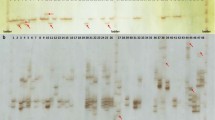Abstract.
Microsatellite DNA markers of ten SSR loci and 248 RAPD loci (resolved by 26 RAPD primers) were used for DNA fingerprinting and differentiation of 17 widely grown Populus x canadensis syn. Populus x euramericana (interspecific Populus deltoides × Populus nigra hybrids) cultivars ('Baden 431', 'Blanc du Poitou', 'Canada Blanc', 'Dorskamp 925', 'Eugenei', 'Gelrica', 'Grandis', 'Heidemij', 'I-55/56', 'I-132/56', 'I-214', 'Jacometti', 'Ostia', 'Regenerata', 'Robusta', 'Steckby' and 'Zurich 03/3'), and determination of their genetic interrelationships. Informativeness of microsatellite and RAPD markers was also evaluated in comparison with allozyme markers for clone/cultivar identification in P. x canadensis. High microsatellite DNA and RAPD genetic diversity was observed in the sampled cultivars. All of the 17 P. x canadensis cultivars could be differentiated by their multilocus genotypes at four SSR loci, and were heterozygous for their parental species-specific alleles at the PTR6 SSR locus. Except for 'Canada Blanc' and 'Ostia', which had identical RAPD patterns, all cultivars could also be differentiated by RAPD fingerprints produced by each of the two RAPD primers, OPA07 and OPB15. For microsatellites, the mean number of alleles, polymorphic information content, observed heterozygosity, observed number of genotypes and the number of cultivars with unique genotypes per locus was 5.2, 0.64, 0.67, 5.7 and 2.2, respectively. For RAPD markers, the number of haplotypes per locus, and the number of cultivars with unique RAPD profiles per locus were 1.06 and 0.72, respectively. Overall, microsatellite DNA markers were the most informative for DNA fingerprinting of P. x canadensis cultivars. On the per locus basis, microsatellites were about six-times more informative than RAPD markers and about nine-times more informative than allozyme markers. However, on the per primer basis, RAPD markers were more informative. The UPGMA cluster plots separated the 17 cultivars into two major groups based on their microsatellite genotypic similarities, and into three major groups based on their RAPD fragment similarities. Both the microsatellite and RAPD data suggest that the cultivars 'Baden 431', 'Heidemij', 'Robusta' and 'Steckby' are genetically closely related. The inter-cultivar genetic relationships from microsatellite DNA and RAPD markers were consistent with those observed from allozyme markers, and were in general agreement with their speculated origin. Microsatellite DNA and RAPD markers could be used for clone and cultivar identification, varietal control and registration, and stock handling in P. x canadensis.
Similar content being viewed by others
Author information
Authors and Affiliations
Additional information
Electronic Publication
Rights and permissions
About this article
Cite this article
Rajora, .O., Rahman, .M. Microsatellite DNA and RAPD fingerprinting, identification and genetic relationships of hybrid poplar (Populus x canadensis) cultivars. Theor Appl Genet 106, 470–477 (2003). https://doi.org/10.1007/s00122-002-1082-2
Received:
Accepted:
Issue Date:
DOI: https://doi.org/10.1007/s00122-002-1082-2




